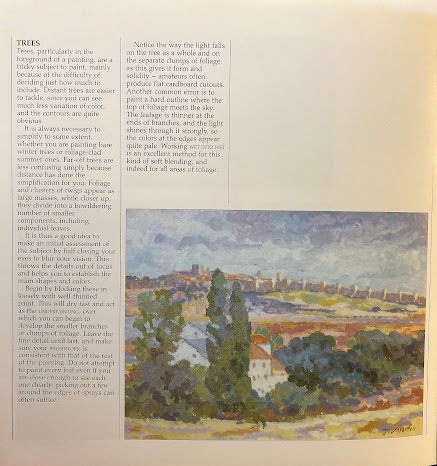There are many reasons to paint out doors. Some artists use it as a way to rejuvenate themselves, others use is a starting point for a later work and still others use it to improve their skills by forcing themselves to work quick on their feet. Some simply want to drink in the beauty of nature, to find fresh, evocative, inspiring and challenging subjects; to spend time in the quiet places; to capture the liveliness of birds or the grace of a red fox; to learn about your environment. And some, like us are painting outdoors to explore creation. Whatever the intent, the basic approaches to starting your paintings are pretty much the same.
Keep in Mind
This is not a studio painting. Instead of two weeks most artists think of field studies as taking two hours. Some do return the next day but usually paint a different viewpoint or scene.
That means we want to make every minute count. I like to spend 15 minutes on my thumbnail sketch; 15-20 minutes on my under drawing/painting; 10-15 minutes on color and the rest of the time painting for a two-three hour outing.
1. The Thumbnail Sketch
The best way to save time is to make time for your thumbnails. They are your blueprints for success. The more you do them, the easier they become. They are where you decide composition, intent, and approach.
Composition
Part of the enjoyment of painting en plein aire is exploring the area for things that interest you. It can be a small detail of a landscape or something that takes in more of the surrounding environment. After a while you get a feeling for what you enjoy looking at. Once you’ve settled on something use your viewfinder (like a camera) and consider your possibilities. Translate these, using simplified large forms to your thumbnails.
Intent
Within your composition identify the center of interest (it does not have to be in the center of the composition). The center of interest does not have to be an object although it can; it can be the way the light falls or reflects or the way two things interact; or the contrast between two forms—but it needs to be defined. The center of interest does not have to be in the center of the page. The center of interest is what you, as an artist want to talk about.
Approach
Generally speaking, oil works from back to front, dark to light and the general to the specific; watercolor from front to back; light to dark and general to the specific but you also want to think about how you are going to tackle each area and what kind of paint application will best support your intent—which will trump the back to front, front to back approach. For example, you may decide that a wet-in-wet approach is best for the background but you want to use drybrush or line work for the foreground. You may decide with oil, that broken color might work best for the distant mountains but a tighter more detailed application is needed for the center of interest. What ever your direction, the thumbnail is the time to think about these things, not after you’ve already put paint on the canvas/paper.
2. Under Drawing/Painting
Once you have thought through your thumbnail sketch mark off the center and transfer the composition to your support. If you are using oil, use French Ultramarine; if you are using watercolor an HB pencil will do. Limit yourself to fifteen minutes and spend the most time on your center of interest. Keep it simple, but give yourself a framework to work in.
3. Color Mixing
Always mix up more color than you think you will need. And always mix up at least five to six values. On the green side, mix yellow, blue and gray greens to cover the wide color range of green in the summer. Mix your “black” not from the tube but from a cool and warm color so that you can adjust the temperature to the shadow color.
The shadow color is always the opposite color the illumination. If the light is warm, the shadow is cool. Reddest at sunrise and sunset, sunlight takes on a neutral color at 10 AM and 2 PM at approximately 5500K (Kelvin). The sky plays a huge role in reflected light, as do objects around your subject.
4. Application
As mentioned under approach, start with your plan. Usually, roughing in the areas of less interest and leaving time for your center of interest. I sometimes find that limiting my time on the secondary interest areas (for example using a simple blocking method) and allowing the most time on my center of interest puts my time to better use. Always keep in mind why you are painting en plein aire and keep your goals attainable. Most of all enjoy the experience.
Painting Creation
Friday, June 10, 2022
Getting Started
Subscribe to:
Comments (Atom)
Getting Started
There are many reasons to paint out doors. Some artists use it as a way to rejuvenate themselves, others use is a starting point for a later...
-
There are many reasons to paint out doors. Some artists use it as a way to rejuvenate themselves, others use is a starting point for a later...






